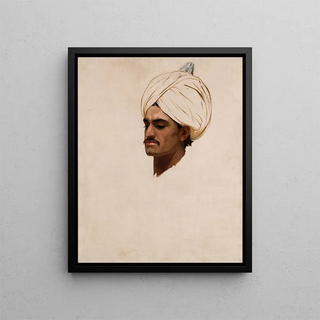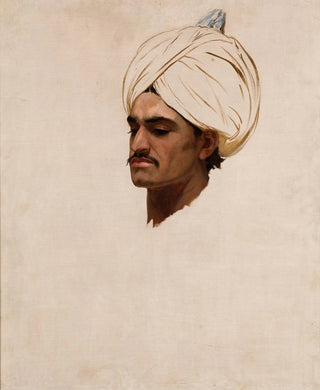Art print | Study of an Arab head - Stanisław von Chlebowski


View from behind

Frame (optional)
Art print Étude d'une tête d'Arabe - Stanisław von Chlebowski – Engaging Introduction
L'art has this unique power to transcend time and space, and the artwork "Étude d'une tête d'Arabe" by Stanisław von Chlebowski is a striking illustration of this. This painting, which captures the essence of a face with a strong and enigmatic character, invites us to delve into a universe where Orientalism and realism meet. Chlebowski, through this study, manages to capture not only the physical features of his model but also a psychological depth that evokes emotion. Contemplating this piece, one feels an intimate connection with the subject, an invitation to explore the hidden stories behind each line and shadow.
Style and uniqueness of the work
Chlebowski's style is characterized by finesse in execution and attention to detail that makes his work immediately recognizable. In "Étude d'une tête d'Arabe," the artist employs a palette of warm, earthy colors reminiscent of Middle Eastern landscapes, while highlighting the richness of textures. The play of light and shadow gives an almost sculptural dimension to the depicted face, accentuating the model's features with remarkable precision. The way Chlebowski captures the nuances of the skin and the reflections in the eyes demonstrates technical mastery that goes beyond simple representation. Each brushstroke seems to be a statement, an exploration of cultural identities and human emotions.
The artist and his influence
Stanisław von Chlebowski, born in Poland and active within European artistic circles, established himself as a major figure in 19th-century Orientalism. His artistic training, enriched by travels and encounters, allowed him to incorporate diverse influences into his work. Chlebowski was always fascinated by the Orient and its cultures, an interest that is evident in his artworks. By choosing to depict Arab subjects, he contributed to shaping a romanticized and idealized vision of the Orient, while addressing universal themes such as identity, beauty, and melancholy. His artistic legacy endures today, inspiring many contemporary artists to explore the

Matte finish

View from behind

Frame (optional)
Art print Étude d'une tête d'Arabe - Stanisław von Chlebowski – Engaging Introduction
L'art has this unique power to transcend time and space, and the artwork "Étude d'une tête d'Arabe" by Stanisław von Chlebowski is a striking illustration of this. This painting, which captures the essence of a face with a strong and enigmatic character, invites us to delve into a universe where Orientalism and realism meet. Chlebowski, through this study, manages to capture not only the physical features of his model but also a psychological depth that evokes emotion. Contemplating this piece, one feels an intimate connection with the subject, an invitation to explore the hidden stories behind each line and shadow.
Style and uniqueness of the work
Chlebowski's style is characterized by finesse in execution and attention to detail that makes his work immediately recognizable. In "Étude d'une tête d'Arabe," the artist employs a palette of warm, earthy colors reminiscent of Middle Eastern landscapes, while highlighting the richness of textures. The play of light and shadow gives an almost sculptural dimension to the depicted face, accentuating the model's features with remarkable precision. The way Chlebowski captures the nuances of the skin and the reflections in the eyes demonstrates technical mastery that goes beyond simple representation. Each brushstroke seems to be a statement, an exploration of cultural identities and human emotions.
The artist and his influence
Stanisław von Chlebowski, born in Poland and active within European artistic circles, established himself as a major figure in 19th-century Orientalism. His artistic training, enriched by travels and encounters, allowed him to incorporate diverse influences into his work. Chlebowski was always fascinated by the Orient and its cultures, an interest that is evident in his artworks. By choosing to depict Arab subjects, he contributed to shaping a romanticized and idealized vision of the Orient, while addressing universal themes such as identity, beauty, and melancholy. His artistic legacy endures today, inspiring many contemporary artists to explore the






